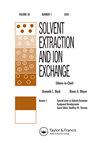Development of Chemical Procedures for Isotope Harvesting: Separation of Trace Hafnium from Tungsten
IF 2.1
4区 化学
Q3 CHEMISTRY, MULTIDISCIPLINARY
引用次数: 1
Abstract
ABSTRACT The separation of trace hafnium from bulk tungsten alloys is of interest for isotope harvesting at the National Superconducting Cyclotron Laboratory and the Facility for Rare Ion Beams because 172Hf, the parent of 172Lu, accumulates in tungsten alloy beam blockers at these facilities. In this work, a procedure for the separation of trace hafnium from a bulk tungsten alloy (454 g) was established using tracer isotopes (175Hf, 88Zr, 173Lu, and 88Y). The procedure employed dissolution in an HF–HNO3 solution followed by a calcium fluoride precipitation, and then extraction chromatography was used for more selective separation steps. Two stages of column separations using LN resin (HDEHP based) and TRU resin (CMPO based) were performed. Gamma-ray spectroscopy and mass spectrometry were used to analyze the final hafnium sample and follow the steps in the chemical processing. The final recovery of hafnium was high (90 ± 8)%, and the mass of tungsten and other transition metals was reduced to near background levels (as determined by ICP-MS of the blank acid solutions). Zirconium follows hafnium quantitatively in this procedure; there was no detectable 173Lu in the final hafnium sample.同位素采集化学程序的发展:从钨中分离痕量铪
摘要从大块钨合金中分离痕量铪对国家超导回旋加速器实验室和稀有离子束设施的同位素采集很有兴趣,因为172Lu的母体172Hf在这些设施的钨合金束阻断剂中积累。在这项工作中,从大块钨合金(454 g) 使用示踪同位素(175Hf、88Zr、173Lu和88Y)建立。该程序采用在HF–HNO3溶液中溶解,然后进行氟化钙沉淀,然后使用萃取色谱进行更具选择性的分离步骤。使用LN树脂(基于HDEHP)和TRU树脂(基于CMPO)进行两个阶段的柱分离。伽马射线光谱法和质谱法用于分析最终的铪样品,并遵循化学处理的步骤。铪的最终回收率很高(90 ± 8) %,钨和其他过渡金属的质量降低到接近背景水平(通过空白酸溶液的ICP-MS测定)。在该过程中,锆定量地跟随铪;在最终的铪样品中没有检测到173Lu。
本文章由计算机程序翻译,如有差异,请以英文原文为准。
求助全文
约1分钟内获得全文
求助全文
来源期刊
CiteScore
4.40
自引率
5.00%
发文量
15
审稿时长
8.4 months
期刊介绍:
Solvent Extraction and Ion Exchange is an international journal that publishes original research papers, reviews, and notes that address all aspects of solvent extraction, ion exchange, and closely related methods involving, for example, liquid membranes, extraction chromatography, supercritical fluids, ionic liquids, microfluidics, and adsorption. We welcome submissions that look at: The underlying principles in solvent extraction and ion exchange; Solvent extraction and ion exchange process development; New materials or reagents, their syntheses and properties; Computational methods of molecular design and simulation; Advances in equipment, fluid dynamics, and engineering; Interfacial phenomena, kinetics, and coalescence; Spectroscopic and diffraction analysis of structure and dynamics; Host-guest chemistry, ion receptors, and molecular recognition.

 求助内容:
求助内容: 应助结果提醒方式:
应助结果提醒方式:


